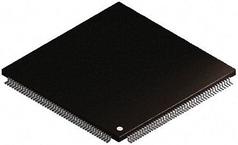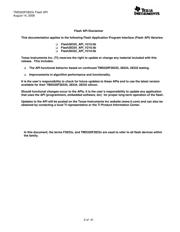Datasheet 搜索 > 微控制器 > TI(德州仪器) > TMS320F28334PGFA 数据手册 > TMS320F28334PGFA 其他数据使用手册 6/41 页

 器件3D模型
器件3D模型¥ 160.916
TMS320F28334PGFA 其他数据使用手册 - TI(德州仪器)
制造商:
TI(德州仪器)
分类:
微控制器
封装:
LQFP-176
描述:
TEXAS INSTRUMENTS TMS320F28334PGFA. 芯片, 数字信号控制器, 32位, 256KB, 150MHz, 1.995V, LQFP176
Pictures:
3D模型
符号图
焊盘图
引脚图
产品图
页面导航:
功能描述在P23P24P25P27P30P33P35
导航目录
TMS320F28334PGFA数据手册
Page:
of 41 Go
若手册格式错乱,请下载阅览PDF原文件

TMS320F2833x Flash API
August 14, 2008
6 of 41
3. Introduction: Flash API Programming Fundamentals
The Flash Application Program Interface (Flash API) consists of well-documented functions that the client
application calls to perform flash specific operations. The flash array and One Time Programmable (OTP)
block on the device are managed via CPU execution of algorithms in the Flash API library. Texas
Instruments Inc (TI) provides API functions to erase, program and verify the flash array as briefly described
here:
Erase:
Erase operates on the flash array only. The One Time Programmable (OTP) block cannot be erased once it has
been programmed. The Erase function is used to set the flash array contents to all 1’s (0xFFFF). The erase
operation includes the following steps:
Pre-compact all sectors. This step is to make sure no bits are in an over-erased
or “depleted” state before attempting the sector erase. Depletion can occur as a
result of stopping the erase function before its post-condition or compaction step
can complete. Even with this step, halting the erase function before it completes
is not recommended.
Pre-condition or “clear” the sector to be erased. This step programs all of the bits
in the sector to 0x0000 to allow for an even erase across the sector.
Erase the sector. This step removes charge from the bits in the sector until all of
the bits within the sector are erased.
Post-condition or compact the sector that was erased. This step makes sure no
bits are left in an over-erased (or depleted) state.
The smallest amount of memory that can be erased at a time is a single sector. Some traditional algorithms,
such as those for the 240x family, require that the flash be pre-conditioned or “cleared” before it is erased. The
Flash API erase function includes the flash pre-conditioning and a separate “clear” step is not required.
The flash array and OTP block are in an erased state (all 0xFFFF) when the device is shipped from the factory.
Program:
The program function operates on both the flash array and the OTP block. This function is used to put
application code and data into the flash array or OTP. The program function can only change bits from a 1 to a
0. Bits cannot be moved from a 0 back to a 1 by the programming function. For this reason, flash is typically in
an erased state (all 0xFFFF) before calling the programming function. The programming function operates on a
single 16-bit word at a time.
To protect the flash or OTP and allow for user flexibility, the program operation will not attempt to program
any bit that has previously been programmed. For example, a flash or OTP location can be programmed with
0xFFFE and later the same location can be programmed with 0xFFFC without going through an erase cycle.
During the second programming call, the program operation will detect that bit 0 was already programmed
and will only program bit 1.
Verify:
The erase and program functions perform verification with voltage margin as they execute. The verify function
provides a second check via a CPU read that can be run to verify the flash contents against the reference
value. The verify function operates on both the flash array and OTP blocks.
To integrate one of the Flash APIs into your application you will need to follow the steps described within this
document. The checklist provided in section 5 gives an overview of the required steps and can be used to
guide you through the process. While integrating the API, keep the following Do’s and Don’ts in mind:
User's
Application
Flash API
Flash Algos
OTP/Flash
Array Control
Flash/OTP
Memory
Zero-Waitstate SARAM
器件 Datasheet 文档搜索
AiEMA 数据库涵盖高达 72,405,303 个元件的数据手册,每天更新 5,000 多个 PDF 文件






